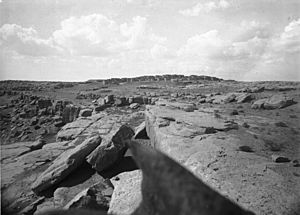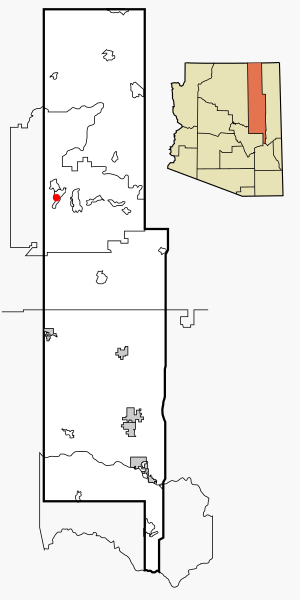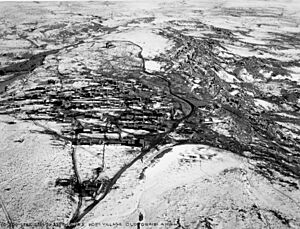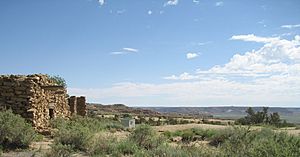Oraibi, Arizona facts for kids
Quick facts for kids
Oraibi, Arizona
|
|
|---|---|

The Hopi pueblo of Oraibi from the southwest
|
|

Location in Navajo County and the state of Arizona
|
|
| Country | United States |
| State | Arizona |
| County | Navajo |
| Elevation | 6,057 ft (1,846 m) |
| Time zone | MST |
| GNIS feature ID | 45584 |
Oraibi, also called Old Oraibi, is a very old Hopi village in Navajo County, Arizona, USA. The Hopi people call it Orayvi. It is located on Third Mesa within the Hopi Reservation, close to Kykotsmovi Village.
Oraibi is thought to be the oldest place in the United States where people have lived continuously. It has a long and interesting history, especially how it changed over time.
History of Oraibi
Oraibi was likely founded before the year 1100 AD. This makes it possibly the oldest town in the United States that has always been lived in. Experts believe that bad droughts in the late 1200s made the Hopi people leave smaller villages. They then moved together into bigger towns like Oraibi.
As more people moved to Oraibi, it became the most important Hopi settlement. By 1890, about 905 people lived there. This was almost half of all the Hopi people living in settlements at that time.
Early European Contact
Oraibi was not known to Europeans until about 1540. A Spanish explorer named Pedro de Tovar found the Hopi people. He was part of the Coronado expedition, which was looking for the famous Seven Cities of Gold.
Europeans did not visit often until 1629. That year, the San Francisco mission was built in the village. In 1680, the Pueblo Revolt happened. This event reduced Spanish power in the area, and the mission closed. Later attempts to build missions in Hopi villages failed. Today, you can still see the ruins of the old mission.
The Oraibi Split
Between 1850 and 1860, the Hopi people started to have more contact with outsiders. These included missionaries, traders, and government surveyors. This contact became more regular after 1870. An "Indian agent" was assigned to the Hopi, and the Hopi Indian Agency was set up in Keams Canyon in 1874.
Contact with the US government grew even more when the Hopi Reservation was created in 1882. This brought many changes to the Hopi way of life. Missionaries tried harder to change Hopi beliefs. Sometimes, Hopi children were taken from their homes and made to go to school. This exposed them to new cultures.
In 1890, some residents who were more open to new ideas moved closer to a trading post. They started a new village called Kykotsmovi, sometimes known as New Oraibi. There was growing tension between two groups:
- The "friendlies" (or "New Hopi") were open to new cultural influences.
- The "hostiles" (or "Traditionalists"), led by Yukiuma, wanted to keep the old Hopi ways.
This disagreement led to an event called the "Oraibi Split" in 1906. Leaders from both sides had a peaceful competition to decide what would happen. The "hostiles" (traditionalists) were asked to leave. They went on to create the village of Hotevilla. Later, some of these displaced residents tried to come back. This caused another split, and a second group founded Bacavi.
After losing many of its people, Oraibi was no longer the main center of Hopi culture. Today, Kykotsmovi Village is where the Hopi tribal government is located.
Oraibi Today
Even though the "friendlies" won the Oraibi Split, Old Oraibi has kept a more traditional Hopi way of life. It has resisted adopting the more modern culture seen in Kykotsmovi.
Visitors are welcome in the pueblo, and a short road connects to Arizona State Route 264. However, the people who live there are very private. They do not allow photographs to be taken in the town.
Old Oraibi is listed on the National Register of Historic Places. It was also named a National Historic Landmark in 1964.
See also
- In Spanish: Oraibi (Arizona) para niños






